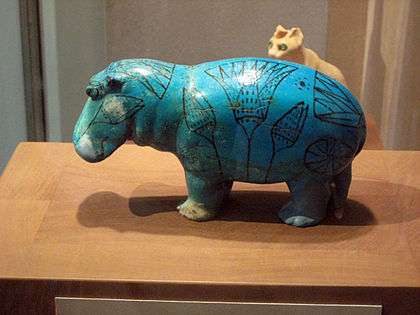William the Faience Hippopotamus

William is the nickname of a faience hippopotamus from the Middle Kingdom of Egypt in the collection of the Metropolitan Museum of Art who serves as an informal mascot of the museum. Found in a shaft associated with the tomb chapel of "The Steward, Senbi" at Meir, Upper Egypt, William dates from c. 1961 – 1878 B.C. during the reigns of Senwosret I and Senwosret II.[1] This small figurine in Egyptian faience, a clay-less material, has become popular not only for his endearing appearance but also because his defining characteristics illustrate many of the most salient facets of craft production in ancient Egypt during this time.
William is only one of several objects associated with the tomb of "The Steward, Senbi" that were acquired by the Metropolitan Museum in 1917. According to the Museum’s Bulletin from that year, this hippopotamus is a “particularly fine example of a type found, in common with various other animal forms, among the funerary furnishings of tombs of the Middle Kingdom” and also an exemplary piece of Egyptian faience.[2]
Egyptian faience
Related to glass insofar as it attains a "vitreous" appearance, Egyptian faience was, according to David F. Grose, “a material made from powdered quartz covered with a true vitreous coating.” Significantly more porous and malleable than glass proper, faience could be shaped by hand or cast in molds to create vessels or other objects.[3] While similar raw materials are involved in the creation of both faience and glass (crushed quartz or sand mixed with lime and either natron or plant ash), faience ultimately lacks the rigid crystalline structure of found in modern glass. Significantly, both glass and faience were used, according to Paul T. Nicholson, to imitate semi-precious stones in less costly materials, and both were valued for their beauty and durability.[4] Although not pottery on a strict definition, since it contains no clay, faience is often treated as pottery.
Style
Moreover, this jewel-like statuette of a species that can no longer be found in modern day Egypt demonstrates the importance of a variety of iconographic styles in Middle Kingdom era burial practices. As Nicholson writes, animal figures were common during this period and “hippopotamus figurines, usually decorated with aquatic plants, probably symbolized the revitalizing properties of the Nile” and may have held some kind of religious significance, as they were sometimes associated with one of the forms of Seth.[5] As not all hippo statues from this era were elaborately painted, William is a particularly important example; he has been “covered with a decoration in black line of lotus flowers, buds, and leaves” to signal his “natural surroundings among the lowlands of the Nile.”[2] As noted in the Metropolitan Museum’s summary, the hippopotamus was one of the most threatening animals for ancient Egyptians and, in this case, three of William’s legs were purposely broken to prevent him from harming the deceased in the afterlife (the museum has since restored these legs).[1] William can be seen in Gallery 111 at the Metropolitan Museum of Art alongside other objects related to Senbi's tomb.
Name
In the early 20th century, Captain H.M. Raleigh and his family owned a photograph of the hippopotamus, and began to refer to him as William. Raleigh published an article about the hippo for the magazine Punch on March 18, 1931, in which he wrote, "He is described on the back of the frame as "Hippopotamus with Lotus Flowers, Buds and Leaves, XII Dynasty (about 1950 B.C.), Series VII, Number i, Egyptian Faience;" but to us he is simply William."[6][7][8] The article was reprinted in the Metropolitan Museum of Art's Bulletin in June 1931, and the name stuck.[6] In 1936 the Met released a book entitled William and his Friends: A Group of Notable Creatures in the Metropolitan Museum of Art.[9] Since then, William has continued to appear in some museum logos and merchandise for both children and adults. The Met first began selling cast reproductions of William in the 1950's[7] which today are manufactured by M. Hart Pottery.[10]
References
- 1 2 "The Metropolitan Museum of Art - Hippopotamus". Metmuseum.org. 2013-12-03. Retrieved 2013-12-13.
- 1 2 "An Egyptian Hippopotamus Figure." Bulletin of the Metropolitan Museum of Art 4 (April 1917): 78.
- ↑ David Frederick Grose, The Toledo Museum of Art, Early Ancient Glass: Core-Formed, Rod-Formed, and Cast Vessels and Objects from the Late Bronze Age to the Early Roman Empire, 1600 BC to AD 50 (Manchester: Hudson Hills Press, 1999), 29.
- ↑ Paul T. Nicholson, Egyptian Faience and Glass (Buckinghamshire: Shire, 1993), 45.
- ↑ Nicholson, Egyptian Faience and Glass, 23.
- 1 2 http://www.metmuseum.org/~/media/Files/Give%20and%20Join/Planned%20Giving/William%20Bulletin%20article.pdf
- 1 2 Schneider, Daniel (29 December 2002). "F.Y.I.". New York Times. New York City.
- ↑ http://www.metmuseum.org/content/interactives/Learn_About_Color/william.swf?movieName=william
- ↑ "William and his Friends, A Group of Notable Creatures in The Metropolitan Museum of Art". American Institute of Graphic Arts.
- ↑ "Museum Reproductions".